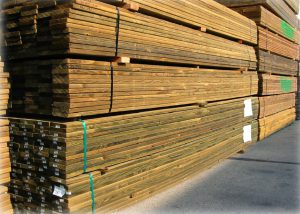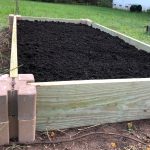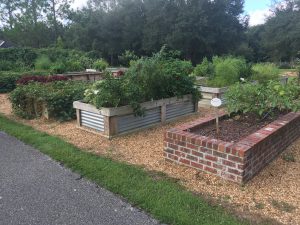Despite a sharp increase in costs recently, wood products remain a common landscape and garden material. They can be used for building structures, such as arbors and sheds, or for hardscapes and garden accessories, like raised vegetable garden beds or landscape timbers used for edging. Many homeowners may be confused on the safety of using certain wood products, especially around plants grown for consumption. This article hopes to explain the various options and the known safety concerns.
Gardeners seem to be mostly concerned with the safety of using preserved wood products around food plants. Pressure-treated lumber is usually suggested whenever the material will be exposed to the elements and especially when in contact with the soil. Non-treated lumber, while free of any preservatives, will simply not last as long in the landscape, especially in Florida where we have a long growing season, are wet, and have lots of organisms – termites, fungus, etc. – that love to break down wood. If the wood is in direct contact with the soil, such as in a raised bed garden, you can expect non-treated lumber to last a year, maybe two, compared to three to five years with pressure-treated lumber. Wood products used for structures not in contact with soil can last significantly longer but, even then, non-treated products will need to be protected with sealers or paints to extend their longevity.
To address the safety of pressure-treated wood products, the wood products industry, and the federal government, in 2004, phased out the use of potentially hazardous chemicals used in the process – namely arsenic and chromium. Wood products preserved with these compounds were either chromated copper arsenate (CCA), ammoniacal copper arsenate (ACA), or acid copper chromate (ACC). Since 2004, much of the lumber available at hardware stores is micronized copper azole (CA) or alkaline copper quaternary ammonium (ACQ). The abbreviations for each are usually found on the little label stapled on to the lumber. So, while copper used to prevent fungal damage is still a component of pressure-treated lumber, the arsenic and chromium used to protect the wood from insect damage has been removed. Railroad ties, sometimes still in use and for sale, are much more toxic than even the older pressure-treated products because of the use of creosote and other oil-based compounds to preserve the wood.

Preserved wood products contain the preservation method on the tag stapled to the product. Credit: USDA Forest Products Lab
By removing these potentially hazardous compounds from pressure-treated wood products, gardeners should expect no adverse effects from it’s use. A Human and Ecological Risk Assessment of ACQ treated wood that was done in 2007 found exposure levels well below health benchmarks when directly contacting the wood and even with some ingestion of the material, such as contacting the wood and putting hands directly in mouth.
Even though these hazardous materials have been removed, there are still some precautions you should take when using pressure-treated lumber. These precautions include wearing a mask when cutting the lumber and not burning the lumber. This is to prevent inhalation of the chemically treated sawdust or smoke. It’s also not recommended to compost pressure-treated lumber since the chemicals can affect the microbes in your compost pile.
For those still concerned with the use of pressure-treated wood products around food crops, there are other options. In addition to using non-treated wood products or a plastic liner to separate the pressure-treated lumber from your edible garden plants. There are many other materials that can be used instead. Concrete blocks or other stone materials can be a good option. Logs from cut trees, although will rot like non-treated lumbers, can add a natural type of look to the garden.
For additional information on pressure-treated lumber, visit this Clemson University website – https://hgic.clemson.edu/factsheet/treated-wood-in-the-landscape/. If you have any questions about the use of wood products in the garden or on how to build a raised bed garden, contact your local UF/IFAS Extension office.
- Let Extension Diagnose Your Landscape Issues - May 28, 2025
- No Mow March 2025! - February 27, 2025
- New Year’s Resolution Ideas for Gardeners - January 16, 2025


